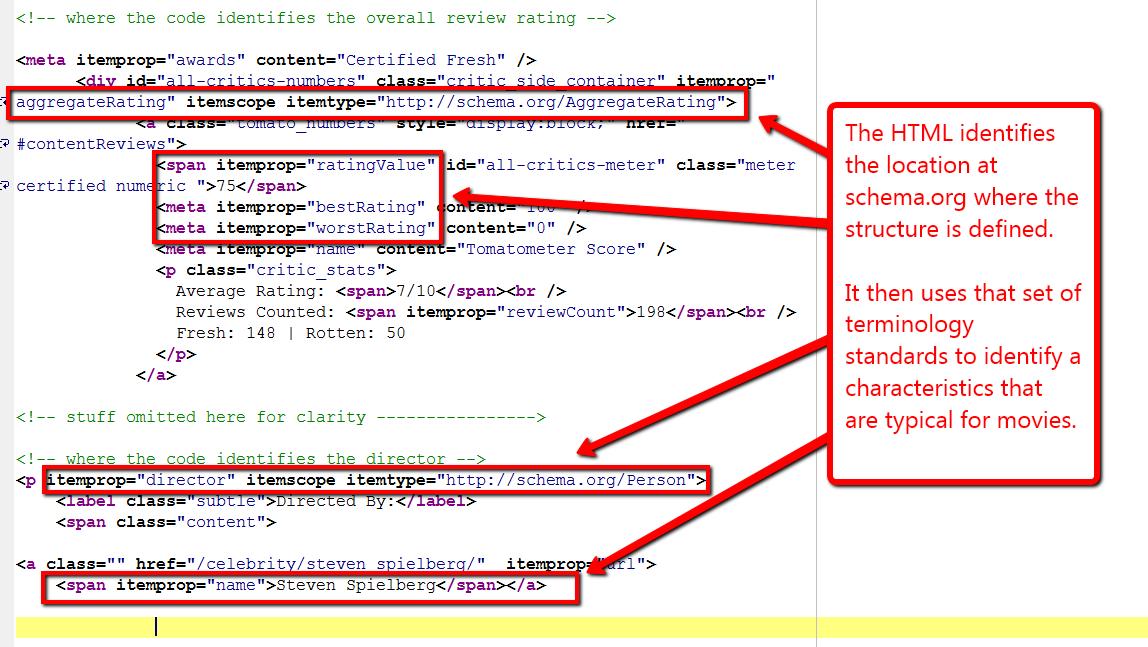In the first 2 parts of this series we reviewed the role of structured data and rich snippets in search results, but we didn’t get to the nitty gritty of implementation. This part of the article will give you a nudge in the direction of placing the necessary code in your web pages to “structure” your “data” in a way that will be understood by Google, Bing, and Yahoo.
Notice my use of the extremely technical word “nudge.” This will not be an exhaustive tutorial. This area of development is not necessarily easy. If you’re an SEO learning how to do it, be prepared either
1) To make use of a professional developer who has experience with the type of structured data defined at www.schema.org, or
2) Invest some of your own time in further learning, practice and experimentation. At the end of this article I’ll give you a couple of resources for that.
I also intend to give you a rule of thumb for deciding whether now is the time for you to aggressively pursue structured data in your web pages and SEO.
Implementing Rich Snippets
So last time we learned that rich snippets show up in search results looking something like this:
Note in this screen capture detail that the search results themselves display the review count from Rotten Tomatoes, as well as the director and the top-billed cast. So how does Google know to display those details? It all goes back to the HTML code and the standards that are defined at schema.org. Here are a few snippets from the page that this search result takes you to:
This is an example of how the schema.org website and project becomes the glue that starts to hold structured data and rich snippets together.
Acknowledgement: the definitions at schema.org were not crafted out of whole cloth by the big three search engines. Schema.org is actually based on a pre-existing standard called Microdata, which was developed by the Web Hypertext Application Technology Working Group (WHATWG). You can read more about WHATWG here [make this a link to the Wikipedia article].
Before you conclude that this should be an easy fix, you need to ponder the complexity of what you’re trying to accomplish. For example if look at the reference page at www.schema.org/Movies you’ll see that there are 55 different properties that might apply. And some of those properties are drawn from broader categories that are shared with other types of data, such as “creative work.”
It’s easy to get lost in the data, so at this point you have a couple of options. First of all, if you use a common development platform such as WordPress, there are plugins that promise to make the use of structured data relatively seamless and easy to implement without having to dig too deeply into either schema.org or your own source code.
Here’s a Big Qualification and an even BIGGER Request
Qualification: We have not had a chance to test any of the plugins, so we don’t know how good they are.
Request: If you have experience with any tools, especially WordPress plugins, that ease the pain of structure data, please leave a comment with your opinions below. We and our readers would be anxious to learn from you.
The other way to avoid getting lost in the data might be to not participate. Yet.
Although we do believe that structured data will become a necessity for many types of data, it won’t become necessary for everything, and right now many structured data don’t seem to be playing a heavy role in search engine results. So our recommendation is to first decide whether the page you are optimizing needs structured data by reviewing the results.
How Can You Tell if it’s Important Yet?
Take the set of keywords that your page is targeting. Conduct a Google search on several of them. Scan the results and look for any rich snippets. In other words see whether the search results show data that normally would not be expected in a conventional title tag or meta description tag. If nothing like that shows up, you probably are not going to be significantly benefited by building structured data in your page.
That having been said. If you are able to anticipate the movement of a search segment toward structured data and get ahead of it, your listing on the SERP could be the first one to display rich snippets, and therefore can dominate with a stronger visual presence and more active engagement with your target customer.
Structured Data Resources
Now, about those resources for learning more. We suggest the following as you pursue your own structured data adventure (and yes, we know that it’s sort of stupid to call anything with the description “structured data” an adventure, but we’re trying to keep this interesting for you).
The getting started page of schema.org: http://schema.org/docs/gs.html
The announcement on Google’s Webmaster Central blog: http://googlewebmastercentral.blogspot.com/2011/06/introducing-schemaorg-search-engines.html
Google’s tool for testing your structured data to see if it actually will produce rich snippets: http://www.google.com/webmasters/tools/richsnippets
Part 1 of our series of articles on Structured Data: Introduction to Structured Data http://www.rockymountainsearchacademy.com/2012/12/10/introduction-to-structured-data
Part 2 of our series of articles on Structured Data: Introduction to Rich Snippets http://www.rockymountainsearchacademy.com/2012/12/10/introduction-to-structured-data




